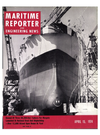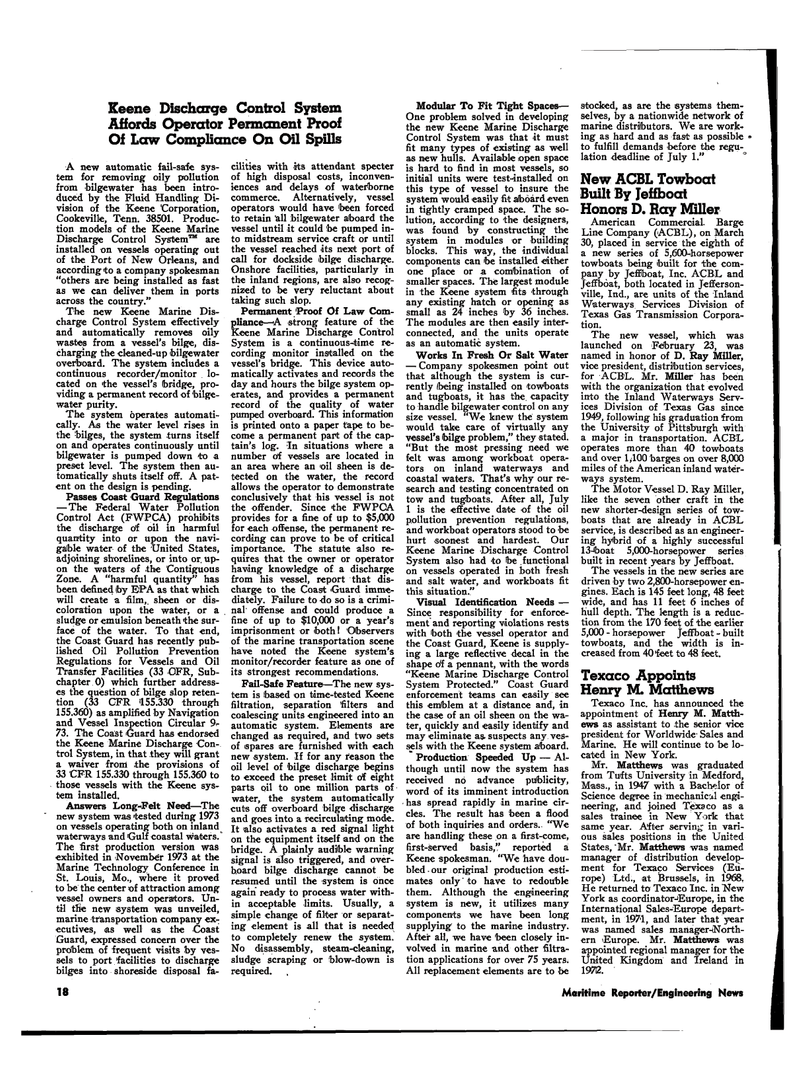
Page 16: of Maritime Reporter Magazine (April 15, 1974)
Read this page in Pdf, Flash or Html5 edition of April 15, 1974 Maritime Reporter Magazine
Keene Discharge Control System
Affords Operator Permanent Proof
Of Law Compliance On Oil Spills
A new automatic fail-safe sys- tem for removing oily pollution from bilgewater has been intro- duced by the Fluid Handling Di- vision of the Keene 'Corporation,
Cookeville, Tenn. 38501. Produc- tion models of the Keene Marine
Discharge Control System™ are installed on vessels operating out of the Port of New Orleans, and according to a company spokesman "others are being installed as fast as we can deliver them in ports across the country."
The new Keene Marine Dis- charge Control System effectively and automatically removes oily wastes from a vessel's bilge, dis- charging the cleaned-up bilgewater overboard. The system includes a continuous recorder/monitor lo- cated on the vessel's bridge, pro- viding a permanent record of bilge- water purity.
The system operates automati- cally. As the water level rises in the bilges, the system turns itself on and operates continuously until bilgewater is pumped down -to a preset level. The system then au- tomatically shuts itself off. A pat- ent on the design is pending.
Passes Coast Guard Regulations —The Federal Water Pollution
Control Act (FWPCA) prohibits the discharge o'f oil in harmful quantity into or upon the navi- gable water of the United States, adjoining shorelines, or into or. up- on the waters of the Contiguous
Zone. A "harmful quantity" has been defined by EPA as that which will create a film,, sheen or dis- coloration upon the water, or a sludge or emulsion beneath the sur- face of the water. To that end, the Coast Guard has recently pub- lished Oil Pollution Prevention
Regulations for Vessels and Oil
Transfer Facilities (33 CFR, Sub- chapter 0) which further address- es the question of bilge slop reten- tion (33 CFR 155.330 through 155.360) as amplified by Navigation and Vessel Inspection Circular 9<- 73. The Coast Guard has endorsed the Keene Marine Discharge Con- trol System, in that they will grant a waiver from the provisions of 33 CFR 155.330 through 155.360 to those vessels with the Keene sys- tem installed.
Answers Long-Felt Need—The new system was tested during 1973 on vessels operating both on inland waterways and 'Gulf coastal waters.'
The first production version was exhibited in November 1973 at the
Marine Technology Conference in
St. Louis, Mo., where it proved to be the center of attraction among vessel owners and operators. Un- til the new system was unveiled, marine transportation company ex- ecutives, as well as the Coast
Guard, expressed concern over the problem of frequent visits by ves- sels to port 'facilities to discharge bilges into shoreside disposal fa- cilities with its attendant specter of high disposal costs, inconven- iences and delays of waterborne commerce. Alternatively, vessel operators would have 'been forced to retain all bilgewater aboard the vessel until it could 'be pumped in- to midstream service craft or until the vessel reached its nexrt port of call for dockside bilge discharge.
Onshore facilities, particularly in the inland regions, are also recog- nized to be very reluctant about taking such slop.
Permanent 'Proof Of Law Com- pliance—A strong feature of the
Keene Marine Discharge Control
System is a continuous-time re- cording monitor installed on the vessel's bridge. This device auto- matically activates and records the day and hours the bilge system op- erates, and provides a permanent record of the quality of water pumped overboard. This information is printed onto a paper tape to be- come a permanent part of the cap- tain's log. In situations where a number of vessels are located in an area where an oil sheen is de- tected on the water, the record allows the operator to demonstrate conclusively that his vessel is not the offender. Since the FWPCA provides for a fine of up to $5,000 for each offense, the permanent re- cording can prove to be of critical importance. The statute also re- quires that the owner or operator having knowledge of a discharge from his vessel, report that dis- charge to the Coast 'Guard imme- diately. Failure to do so is a crimi- nal offense and could produce a fine of up to $10,(XX) or a year's imprisonment or both! Observers of the marine transportation scene have noted the Keene system's monitor/recorder feature as one of its strongest recommendations.
Fail-Safe Feature—The new sys- tem is based on time-tested Keene filtration, separation 'filters and coalescing units engineered into an automatic system. Elements are changed as required, and two sets of spares are furnished with each new system. If for any reason the oil level of 'bilge discharge begins to exceed the preset limit of eight parts oil to one million parts of water, the system automatically cuts off overboard bilge discharge and goes into a recirculating mode.
It also activates a red signal light on the equipment itself and on the bridge. A plainly audible warning signal is also triggered, and over- board bilge discharge cannot be resumed until the system is once again ready to process water with- in acceptable limits. Usually, a simple change of filter or separat- ing element is all that is needed to completely renew the system.
No disassembly, steam-cleaning, sludge scraping or blow-down is required.
Modular To Fit Tight Spaces-
One problem solved in developing the new Keene Marine Discharge
Control System was that it must fit many types of existing as well as new hulls. Available open space is hard to find in most vessels, so initial units were test-Installed on this type of vessel to insure the system would easily fit aboard even in tightly cramped space. The so- lution, according to the designers, was found by constructing the system in modules or building blocks. This way, the individual components can be installed either one place or a combination of smaller spaces. The largest module in the Keene system fits through any existing hatch or opening as small as 24 inches by 36 inches.
The modules are then easily inter- connected, and the units operate as an automatic system.
Works In Fresh Or Salt Water — Company spokesmen point out that although the system is cur- rently /being installed on towboats and tugboats, it has the capacity to handle bilgewater control on any size vessel. "We knew the system would take care of virtually any vessel's bilge problem," they stated. "But the most pressing need we felt was among workboat opera- tors on inland waterways and coastal waters. That's why our re- search and testing concentrated on tow and tugboats. After all, July 1 is the effective date of the oil pollution prevention regulations, and workboat operators stood to be hurt soonest and hardest. Our
Keene Marine Discharge Control
System also had to be functional on vessels operated in both fresh and salt water, and workboats fit this situation."
Visual Identification Needs —
Since responsibility for enforce- ment and reporting violations rests with both the vessel operator and the Coast Guard, Keene is supply- ing a large reflective decal in the shape of a pennant, with the words "Keene Marine Discharge Control
System Protected." Coast Guard enforcement teams can easily see this emblem at a distance and, in the case of an oil sheen on the wa- ter, quickly and easily identify and may eliminate as. suspects any ves- sels with the Keene system aboard.
Production Speeded Up — Al- though until now the system has received no advance publicity, word of its imminent introduction has spread rapidly in marine cir- cles. The result has been a flood of both inquiries and orders. "We are handling these on a first-come, first-served basis," reported a
Keene spokesman. "We have dou- bled • our original production esti- mates only' to have to redouble them. Although the engineering system is new, it utilizes many components we have been long supplying to the marine industry.
After all, we have 'been closely in- volved in marine and other filtra- tion applications for over 75 years.
All replacement elements are to be stocked, as are the systems them- selves, by a nationwide network of marine distributors. We are work- ing as hard and as fast as possible to fulfill demands before the regu- lation deadline of July 1."
New ACBL Towboat
Built By Ieffboat
Honors D. Ray Miller
American Commercial. Barge
Line Company (ACBL), on March 30, placed in service the eighth of a new series of 5,600-ihorsepower towboats being built for the com- pany by Jeffboat, Inc. ACBL and
Jeffboat, both located in Jefferson- ville, Ind., are units of the Inland
Waterways Services Division of
Texas Gas Transmission Corpora- tion.
The new vessel, which was launched on February 23, was named in honor of D. Ray Miller, vice president, distribution services, for ACBL. Mr. Miller has been with the organization that evolved into the Inland Waterways Serv- ices Division of Texas Gas since 1949, following his graduation from the University of Pittsburgh with a major in transportation. ACBL operates more than 40 towboats and over 1,100 barges on over 8,000 miles of the American inland water- ways system.
The Motor Vessel D. Ray Miller, like the seven other craft in the new shorter-design series of tow- boats that are already in ACBL service, is described as an engineer- ing hybrid of a highly successful 13-boat 5,000-horsepower series built in recent years by Jeffboat.
The vessels in the new series are driven by two 2,800-horsepower en- gines. Each is 145 feet long, 48 feet wide, and has 11 feet 6 inches of hull depth. The length is a reduc- tion from the 170 feet of the earlier 5,000 - horsepower jeffboat - built towboats, and the width is in- creased from 40'feet to 48 feet.
Texaco Appoints
Henry M. Matthews
Texaco Inc. has announced the appointment of Henry M. Matth- ews as assistant to the senior vice president for Worldwide- Sales and
Marine. He will continue to be lo- cated in New York.
Mr. Matthews was graduated from Tufts University in Medford,
Mass., in 1947 with a Bachelor of
Science degree in mechanical engi- neering, and joined Texaco as a sales trainee in New York that same year. A'fter serving in vari- ous sales positions in the United
States, "Mr. Matthews was named manager of distribution develop- ment for Texaco Services (Eu- rope) Ltd., at Brussels, in 1968,
He returned to Texaco Inc. in New
York as coordinator-Europe, in the
International Sales-Europe depart- ment, in 1971, and later that year was named sales manager-iNorth- ern Europe. Mr. Matthews: was appointed regional manager for the
United Kingdom and Ireland in 1972. 18 Maritime Reporter/Engineering News

 15
15

 17
17
